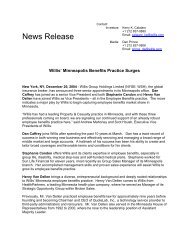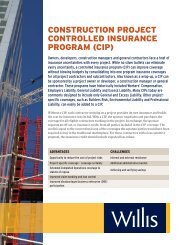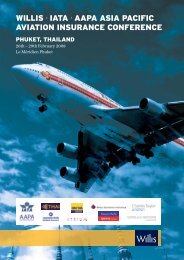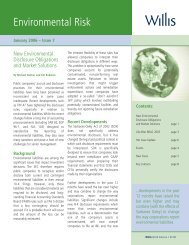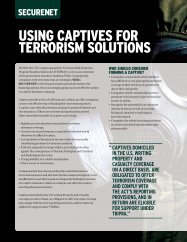CONTROLLING THE INCREASED FIRE RISKS OF IBCs - Willis
CONTROLLING THE INCREASED FIRE RISKS OF IBCs - Willis
CONTROLLING THE INCREASED FIRE RISKS OF IBCs - Willis
You also want an ePaper? Increase the reach of your titles
YUMPU automatically turns print PDFs into web optimized ePapers that Google loves.
LISTED CONTAINERS<br />
NFPA 30 requires that nonmetallic or composite IBC<br />
containers be listed and labeled when used in protected<br />
buildings. The listing and labeling requirements are set by<br />
UL 2368 (Standard for Fire Exposure Testing of<br />
Intermediate Bulk Containers for Flammable and<br />
Combustible Liquids). Storage of liquids in non-listed IBC<br />
containers is classified by NFPA 30 as unprotected storage.<br />
DOT approves nonmetallic or composite IBC containers as<br />
Packing Group II containers UN 31H1 and UN 31H2 (rigid<br />
plastics) or UN 31HZ1 (composites). Containers must pass<br />
physical tests, e.g., pressure tests, drop tests, etc. It should<br />
be noted that explicit fire testing of containers is not<br />
performed for DOT approval.<br />
LIQUID EVALUATION<br />
Flammable liquids, mixtures, emulsions or semi-solids<br />
stored in <strong>IBCs</strong> must have their flash points and/or fire<br />
points measured. Classifications per NFPA 30 are:<br />
Class I (Flammable Liquid) flashpoint below 100°F<br />
(37.8°C)<br />
Class II (Combustible Liquid) flashpoint at or above<br />
100°F (37.8°C) and below 140°F (60°C)<br />
Class IIIA (Combustible Liquid) flashpoint at or above<br />
140°F (60°C), but below 200°F (93°C)<br />
Class IIIB (Combustible Liquid) flashpoint at or above<br />
200°F (93°C)<br />
<strong>FIRE</strong> TESTS<br />
A fire test project was initiated in 1995 by the National Fire<br />
Protection Research Foundation (NFPRP) with the aim of<br />
improving fire protection associated with the storage of<br />
flammable and combustible liquids in non-metallic <strong>IBCs</strong>.<br />
Phases I and II of the project were conducted to develop<br />
protection designs for the palletized storage of flammable<br />
and combustible liquids.<br />
The object of Phase I was to identify where and in what time<br />
period commercially available <strong>IBCs</strong> would fail when<br />
exposed to a hydrocarbon fire. The fire tests were<br />
conducted with a 10-gallon heptane spill fire and a 2-gpm<br />
heptane running fuel fire. The tests were conducted with a<br />
30-minute fire exposure. The tests showed that non-listed<br />
non-metallic IBC units may fail rapidly (in as little as three<br />
minutes) when protected by water sprinklers and subjected<br />
to a pan fire.<br />
2<br />
A follow-up effort (Phase II) was initiated to<br />
conduct large-scale fire tests representing<br />
real-world storage/use scenarios. The<br />
objective was to investigate fire<br />
control/suppression capabilities of fixed fire<br />
suppression systems on an array of <strong>IBCs</strong><br />
stacked both one and two containers high.<br />
The variables investigated included the<br />
design of the fire suppression system, the<br />
storage configuration array and the type of<br />
<strong>IBCs</strong> in the array.<br />
The results of the Phase II tests suggested<br />
that combining fire resistant IBC design with<br />
appropriate water sprinkler protection can<br />
control a fire in the tested storage array.<br />
Additional fire testing in a Phase III study<br />
examined water sprinkler protection criteria<br />
contained in NFPA 30 for large metal<br />
containers stored in racks. For additional<br />
information please refer to the NFPA<br />
website.<br />
Factory Mutual (FM) reports on tests<br />
comparing a wide variety of plastic and<br />
composite <strong>IBCs</strong>. According to their FM Loss<br />
Prevention Data Sheet 7-29 (Flammable<br />
Liquid Storage in Portable Containers)<br />
Section 3.6.5.1, a series of scoping and<br />
intermediate scale fire tests looked at the<br />
general performance of <strong>IBCs</strong> when exposed to<br />
pool fires and spill fires with the hope of<br />
developing a standard test that could be used<br />
to evaluate the fire performance of any IBC.<br />
The test results showed significant<br />
differences in the fire performance of the<br />
tested units, and highlighted the need for<br />
additional performance testing to determine<br />
which units should be used for flammable<br />
liquid storage. FM concluded that additional<br />
research is needed to finalize a method for<br />
evaluating the fire performance of <strong>IBCs</strong>.<br />
Copies of FM Data Sheet 7-29 and other FM<br />
data sheets are now available for download at<br />
no charge upon registration with FM. For<br />
further information please refer to the FM<br />
Global website.<br />
<strong>Willis</strong> North America • 01/10






